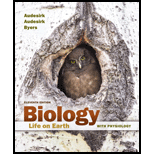
Concept explainers
Health Watch Lack of an Enzyme Leads to Lactose Intolerance
If you enjoy ice cream and pizza, it might be hard for you to imagine life without these treats. However, such dairy containing treats cannot be enjoyed by much of the world’s population. Although al young children normally produce lactase (the enzyme that breaks down lactose, or “milk sugar”), about 65% of people worldwide, including 30 to 50 million people In the United States, produce less of this enzyme as they progress through childhood, a condition called lactose intolerance. In the worst cases, people may experience abdominal pain, flatulence, nausea, and diarrhea after consuming milk products (FIG. E6-2).
Why do people stop synthesizing the enzyme for this nutritious food? From an evolutionary perspective, it makes sense not to continue expending energy to produce an enzyme that has no function. In our early ancestors (who had not yet domesticated livestock), lactase lost its function in very early childhood because, after weaning, these people no longer had access to milk—the main source of lactose. As a result, many modern adults cannot digest lactose because the gene that encodes lactase is regulated by being turned off after weaning. Lactose intolerance is particularly prevalent In people of East Asian, West African, and Native American descent. Genetic studies have revealed that between 10.000 and 6.000 years ago. some people in northern Europe and the Middle East acquired mutations that allowed them to digest lactose throughout their lives. These mutations were advantageous and gradually spread because they provided better nutrition for members of agricultural societies, who could obtain milk as well as meat from their livestock. Their descendants today continue to enjoy milk, ice cream, and extra-cheese pizzas.
FIGURE E6-2 Risky behaviour? For the majority of the world’s adults, drinking milk invites unpleasant consequences.

EVALUATE THIS A family brings their 8-year-old adopted child to a pediatric clinic because she has begun to suffer from diarrhea and stomach cramps after drinking milk. What would the pediatrician suspect was the cause? If tests confirm his suspicions, what approaches would he recommend to deal with the issue? Are there dairy products that would not cause the reaction? How might they work?
Want to see the full answer?
Check out a sample textbook solution
Chapter 6 Solutions
Biology: Life on Earth with Physiology (11th Edition)
- How is a protein destined for the Endoplasmic Reticulum (ER), imported into the ER? Be concise.arrow_forwardFind out about the organisations and the movements aimed at the conservation of our natural resources. Eg Chipko movement and Greenpeace. Make a project report on such an organisation.arrow_forwardWhat are biofertilizers and mention the significancearrow_forward
- PCBs and River Otters: Otters in Washington State’s Green-Duwamish River have high levels of polychlorinated biphenyls (PCBs) in their livers. PCBs can bind to the estrogen receptors in animals and disrupt the endocrine system of these otters. The PCBs seem to increase the estrogen to androgen ratio, skewing the ratio toward too much estrogen. How would increased estrogen affect the river otter population? Based on your reading of the materials in this unit, what factors can affect fertility in humans? Explain how each of the factors affecting human fertility that you described can disrupt the human endocrine system to affect reproduction.arrow_forwardOther than oil and alcohol, are there other liquids you could compare to water (that are liquid at room temperature)? How is water unique compared to these other liquids? What follow-up experiment would you like to do, and how would you relate it to your life?arrow_forwardSelection of Traits What adaptations do scavengers have for locating and feeding on prey? What adaptations do predators have for capturing and consuming prey?arrow_forward
- Competition Between Species What natural processes limit populations from growing too large? What are some resources organisms can compete over in their natural habitat?arrow_forwardSpecies Interactions Explain how predators, prey and scavengers interact. Explain whether predators and scavengers are necessary or beneficial for an ecosystem.arrow_forwardmagine that you are conducting research on fruit type and seed dispersal. You submitted a paper to a peer-reviewed journal that addresses the factors that impact fruit type and seed dispersal mechanisms in plants of Central America. The editor of the journal communicates that your paper may be published if you make ‘minor revisions’ to the document. Describe two characteristics that you would expect in seeds that are dispersed by the wind. Contrast this with what you would expect for seeds that are gathered, buried or eaten by animals, and explain why they are different. (Editor’s note: Providing this information in your discussion will help readers to consider the significance of the research).arrow_forward
 BiochemistryBiochemistryISBN:9781305577206Author:Reginald H. Garrett, Charles M. GrishamPublisher:Cengage Learning
BiochemistryBiochemistryISBN:9781305577206Author:Reginald H. Garrett, Charles M. GrishamPublisher:Cengage Learning Biology: The Unity and Diversity of Life (MindTap...BiologyISBN:9781305073951Author:Cecie Starr, Ralph Taggart, Christine Evers, Lisa StarrPublisher:Cengage Learning
Biology: The Unity and Diversity of Life (MindTap...BiologyISBN:9781305073951Author:Cecie Starr, Ralph Taggart, Christine Evers, Lisa StarrPublisher:Cengage Learning Anatomy & PhysiologyBiologyISBN:9781938168130Author:Kelly A. Young, James A. Wise, Peter DeSaix, Dean H. Kruse, Brandon Poe, Eddie Johnson, Jody E. Johnson, Oksana Korol, J. Gordon Betts, Mark WomblePublisher:OpenStax College
Anatomy & PhysiologyBiologyISBN:9781938168130Author:Kelly A. Young, James A. Wise, Peter DeSaix, Dean H. Kruse, Brandon Poe, Eddie Johnson, Jody E. Johnson, Oksana Korol, J. Gordon Betts, Mark WomblePublisher:OpenStax College- Nutritional Sciences: From Fundamentals to Food, ...Health & NutritionISBN:9781337486415Author:McGuirePublisher:Cengage
 Biology 2eBiologyISBN:9781947172517Author:Matthew Douglas, Jung Choi, Mary Ann ClarkPublisher:OpenStax
Biology 2eBiologyISBN:9781947172517Author:Matthew Douglas, Jung Choi, Mary Ann ClarkPublisher:OpenStax Human Heredity: Principles and Issues (MindTap Co...BiologyISBN:9781305251052Author:Michael CummingsPublisher:Cengage Learning
Human Heredity: Principles and Issues (MindTap Co...BiologyISBN:9781305251052Author:Michael CummingsPublisher:Cengage Learning





